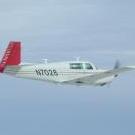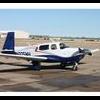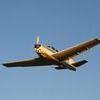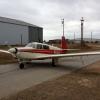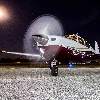Leaderboard
Popular Content
Showing content with the highest reputation on 12/29/2017 in all areas
-
***Update**** I just got back from 8000 feet and I recorded 153KTAS using a four heading method. Thats +6 KTAS!! Temperature was ISA-10 and the pressure was 30.16 giving a DA of 6500. I suspect I should see closer to 155 on a standard day. As a point of reference, I had the LASAR closure to begin with. I would call the cowling mod a huge success in terms of TAS gain!8 points
-
Cold weather up in Michigan this week. Many nights at or below zero. Pulled the plane out yesterday with the car thermometer showing 3 degrees but I’d guess the hanger was closer to 15-20. Clouds were at 2500-3000 agl but clearing to the east. Had planned on shooting some approaches but instead put the power in at a large clearing to climb into clear skies. The old C held 25/25 all the way to 13.5k which was about 750 ft/min. I left the power and it quickly accelerated to a 210 kts ground speed with the healthy tail wind. I think I could get used to that speed! I was amazed how hard it was to drop the altitude. I pulled back to 2350/19 to keep the heat in the engine (-25c oat) but it was very difficult to keep the needle from pushing well into the yellow with anything more than 300-400 ft/min decent. I’ll have to be a lot more careful with altitude planning in the future. Had a good time but was a little cold by the time I landed. Hope to get up again before the new year.6 points
-
Today the weather broke in the morning and I finally got to get Riley up for some preliminary testing. Since it was starting to snow and the ceilings were coming down, the highest I could get was 5500MSL. This didn't allow me to get up high enough to really open her up and see what she would do regarding TAS. What I did instead was set her up like I would fly her to work, i.e. 3500 and 70% power. Very limited testing to day seems to indicate about a 5 knot increase in speed. Whereas I would previously indicate 127KIAS, she now indicates 135IAS. Four heading TAS test seems to agree. I also ran 25 square at 3000 and the below indication was the result. As it stands now, the Ram-Air gives about .7" extra. We are thinking that changing to a smooth-flowing intake straight into the fuel servo will be good for at least .25" thereby making the Ram-Air unnecessary. As it stands now, there are a lot of turns the air has to go through to get the fuel servo creating (i believe) some vacuum and reducing MP. I don't know what .7" of MP translates to in HP, but it's not much. The CHT''s are a nice, even spread, but it's too early to tell is there was any difference in temp. Oil temps with the relocation were a solid 187. I have no reason to believe that will change much in the warmer temps. We shall see. When the weather breaks, I will be able to get up higher and get some good TAS testing done. Overall, I am super happy with the mod! I fly (for work) over the weekend then I am on vacation the first week of January so there probably won't be much flying done until the second week. I will be posting and changes and much better test data in the upcoming weeks. Stay tuned!3 points
-
A few things to keep in mind, from the laws of physics... 1) Slow flight is typical of traffic pattern activities... 90kias or so... 2) 90 is a typical approach speed for IR flight. 3) 90 is usually above Stall speed with low bank angles and flaps at the T/O position... 4) There is a power setting that will maintain 90 and altitude at the same time... 5) You won't be able to cruise to the practice area and set the power setting for slowing down, it will take forever and you will be beyond the practice area quickly. 6) If you want to slow down quickly... remove the power completely while maintaining altitude. A very dynamic situation... trim, trim, trim. Adding configuration changes is like adding brakes... gear down, prop in, flaps down, speed brakes, right rudder, and/or crossed controls... 7) As you get to 90, on target altitude, add back the power setting you have for 90. Finish trimming for 90. 8) expect the power setting for 90, and maintaining altitude, is the same power setting you use approaching the traffic pattern. 9) NA planes use a number near 16”. Throttle fully out is less than 12". MP for a TC'd plane is pretty similar in the traffic pattern. 10) This activity is very much a multi-tasking activity. The faster you can scan instruments and adsorb the details, the better off you will be. 11) Energy Management 102... you are staying at a defined altitude. Too much power you go faster... too little power you go slower 12) The slower you go... more AOA will be needed . 13) More AOA... comes with large helpings of induced drag.... 14) More drag... requires higher MP to maintain altitude... 15) Having The Stall horn sounding... requires an AOA increase that is typical of an ASI below 65(?). 16) High AOAs With Power On to maintain altitude generates a fair amount of (? Add word here) tendency to turn left. 17) defending against the left turn tendency, Use the right rudder to keep the nose point towards a target or keep the ball centered. 18) it always helps to be flying slowly before reaching the practice area. No need to get there quickly to have to add so many changes to get slowed down, and configured properly. 19) The CPL is a lot about demonstrating all the skills of the plane. Speeding up, slowing down, configuration changes, and multi-tasking along the way.... all while maintaining altitude or Vs or something.... 20) Are you familiar with what adding 1” of MP does for your nicely trimmed plane? Adding an inch of MP usually starts a climb of about 100 fpm (generally). If you are on speed and have an unwanted 100fpm climb going.... remove an inch of Mp. 21) Taking out an inch of MP... does the same thing in reverse. 100fpm descent... 22) If your magic reference MP is 16”, and you are flying the traffic pattern level at 90kias... Abeam the numbers, you pull the throttle back 4”... and Check the VSI... it settles around a 400fpm descent... 23) Slow flight and stalls go together. Be real familiar with Stall speed charts, and effects of bank angle, WnB, and crossed controls... 24) Don't forget all the usual training things like clearing turns and the like... safe altitudes are important for this. 25) That would be the top 24 ideas I would be ready to discuss on the way to flying slowly... Keep in mind, this is from the memory of a PP. Not a CFI or CPL. I'm open to discussion... Best regards, -a-3 points
-
One suggestion from my recent experience: The coax for your antennae is quite old. Replace it. It made a significant quality difference for me. Also consider what's not in the panel. How about a 406 MHz ELT while you've got everything torn apart? Dave Piehler N4583H3 points
-
FWIW, my peak EGTs are well over 1500 but I'd remind folks that is relative and the absolute value is (almost) meaningless. Sent from my XT1254 using Tapatalk3 points
-
I Agree that this could go like that: At the same time, when the FARs are as specific as Part 43 Appendix A, I have difficulty with new inspectors desiring things that the regulations do not require. That would be like the police requiring us to stop where there is no stop sign or requiring us to drive at a different speed limit than is listed on the sign.3 points
-
I just wanted to take a moment to thank you all for the mentorship, friendship and inspiration this year. I was struck by the results an AOPA poll which said that the majority of respondents listed a "new rating or certificate" as being a primary goal for 2018. I plan on doing a more writing [for AOPA and Plane and Pilot] on achieving our aviation goals, dealing with setbacks, and overcoming roadblocks. If any of you would like to chime in on your goals for 2018 that would be cool. As well, if you have overcome something to achieve a goal I would love to hear about that too. Posting here is fine, or my email is Jolielucas@charter.net Happy Moo Year!2 points
-
Yep, 500 fpm power on gives me a consistent 170 mph, which is just below the yellow for me. Vintage Electric from the factory has the higher 175-200 mph yellow!2 points
-
If the air is relatively smooth my typical power on descent is usually right around 170mph IAS, sometimes creeping up close to red line (189mph IAS). Just push the nose over and trim out for a 400-500fpm descent, walk the power back and mixture in as you go down to keep MP and EGTs the same as cruise. I know a few others including @Hankdo the same thing.2 points
-
Nothing wrong with a little "yellow" speed in a C. They can take it. I used to do most descents in my C at just below the red line.2 points
-
This is not entirely correct. You will still receive the re-broadcast of their primary transponder from the ground based ADS-B transmitter. The limitation is that this only happens if their standard transponder transmission is received by an ATC radar facility, and that your airplane is receiving the full ADS-B transmission (which means that you have ADS-B Out yourself.).2 points
-
As PT Barnum once said... I don't like Blue book, VREF, or the Mooney Flyer tool. Rather when I bought each of my two Mooneys, I made a spread sheet of every example for sale in the US and Canada. That, over the course of a couple of months, gives a good idea of what airplanes are worth. I made sure to include things such as engine time, panel, autopilot, paint, interior, etc... I found that the difference between the cheapest airworthy airplane on the list and the one with all the bells and whistles, that didn't require any upgrading, was only a few thousand. While upgrading the cheap one to the same equipment list would cost at least 4x that same amount. This business if full of suckers... sorry to say. Sometimes the buyer is the sucker. (I'll score this sweet deal and upgrade it) And sometimes the seller is the sucker (I put all this money into the panel/plane and will never get it back). If you're the sucker seller... at least you hopefully got to enjoy the result of all that money "wasted" for a period of time. But if you're the sucker buyer... I'm sorry. Certainly there are buyers who won't be able to afford the nice example and that's fine. I decided I couldn't afford the nice E I wanted and so bought a nice C instead. I still think that was a better decision than buying the "cheap" E. There are some examples on this forum of owners we all admire, who bought the cheapest Mooney they could find and are happy just to get it airworthy and fly it. @Raptor05121 would be at the top of this list. But even so it was a long and sometimes painful process that involved untold hours of sweat equity on Alex's part. Buying the cheap one and turning it into the nice one while admirable, is always a losing financial proposition. The other possible situation here is when the plane you want doesn't exist. Then you're only option is to find a good candidate for updating and build what you want. But be prepared to spend the money and don't expect to get it back. This is what I'm doing with my 252. I was looking for the best 252 (preferably Encore) that I could find. But all the available examples were nice in all the wrong ways. I'm not impressed by fancy paint and leather interior when corners were cut on the panel, avionics, autopilot, etc. So I bought the best candidate with the best bones and have been spending on it to make it what I want. Someday (hopefully many years from now), there will be a very nice 252 for sale, and I'll be the sucker selling it with a smile on my face for all the many hundreds/thousands of hours I'll have had flying her. Just like my hero's @Bob_Belville and @Marauder. Sorry for rambling on...2 points
-
If you have the cable rigged so it hits the stop before the knob is all the way in it will cause cable housing to slip if you push the control all the way in. This will loosen the housing in the clamp at the governor and it will not get full travel anymore. I know because I use to have a partner who thought that the plane would go faster if he shoved the prop control in as hard as he could.2 points
-
I believe we have it solved. Apparently it was a clogged injector in #3. When we cleaned the injectors the mechanic said he didn't install the #4 injector correctly. Therefore, cleaning the injectors solved the problem and a maintenance induced failure created a new one. This is the problem flight. You can see the #3 EGT high right after takeoff. FF is shown on the CHT chart in blue. This is today's flight after repairing the #4 injector installation. You can see the EGT's within 30DF. I left the cowl flaps open (because I was distracted watching for issues) so the CHT's are a little spread out. I appreciate everyone's comments, suggestions, and concern. Lee2 points
-
This is the email I received from BK: Hello Peter,The KI 300 will be available in late January of 2018. You can place orders with BendixKing dealers now. Best wishes and Happy New Year.Steve1 point
-
How does Fascism differ from Socialism? One claims your life belongs to the state, while the other...? Uh, one claims that government should control the apparatus of production, while the other...? Uh, the NAZIs persecuted Jews, while the USSR...? Uh, one murdered millions of its citizens, while the other...? Uh, running out of false comparisons, here. Do not forget, Bismark was the founder of Socialism in Germany; Hitler was his Philosophical heir. Perhaps you are thinking of Fascism vs. Communism. There, the difference is clear; Communism is more honest. The communists do not allow private property at all, while the fascists allowed private property, but without the capability of doing anything with it without the permission of the state, (which, of course, means there is no such thing as private property). Fascism and Communism are merely opposite sides of the same Socialist coin.1 point
-
That’s valid, and I hadn’t considered the single point of failure for the two aspen displays. Thanks! I think I’ll still opt for the electric standby Gyro with backup battery- again, just because I’m confident in my steam driven flying capabilities due to recurrent, continuous training during my “day job” (which has a steam driven AI/HSI), and the goal of the backup is (or would be) to get me out of IMC, to a safe, VFR type divert- which is in my acceptable risk profile when flying the mooney. I don’t think a third digital AHRS backup Gyro/unit /pfd would change my risk tolerance. tertiary options in the event that I’m shooting an approach, my pitot tube ices up, my pitot heat fails (or I forget to turn it on), would be the electric Gyro, with the option for altitude/airspeed on both my panel mounted GPS (ifd440) and also my iPad with Synthetic vision. Not optimal, but could get the job done I need them to do in a very very stressful (and hopefully very unlikely) pinch.1 point
-
The Nazi's may have called themselves socialist, but they were not socialists. They were fascists. Socialism as we interpret the word in today's formalism is something else entirely. Socialism is usually considered "lefty" and extremist left leads to what happened in Cuba for example under Castro. Extreme righty is what happened under Mussolini in Italy or Germany under Hitler. Extreme being the working word, extreme either way becoming ugly, and in all of those examples they became dictatorships and despite starting left or right came essentially to the same place. I worry today of our future too. But besides an extreme right, fascist dictatorship, the Nazi's distinguished themselves in history with a program of directed genocide. As amazing as their engineering achievements were, I always get the creeps in a museum when I see anything with their swastika markings. I think it is important that there exist museums lest we forget: "Those who cannot remember the past are condemned to repeat it. George Santayana". And I repeat I don't begrudge anyone for keeping that stuff, but it does give me the creeps because I think of gas chambers that the airplane fought for at the same time I think of the airplane that symbol was cut from.1 point
-
1 point
-
I still have some of the ones from the thread above. Yours for the cost of shipping and a padded envelope.. When I run out of the ones I had made on the first run I'll probably charge $20 plus shipping in the future.1 point
-
The most experienced instructors I've worked with don't seem to particularly care what configuration is used for slow flight: clean, flaps only, or flaps and gear are all OK. The FAA commercial pilot ACS (do you use this in the Great White North?) doesn't require any particular configuration for the slow flight task, so it really is the pilot's choice... in theory. In practice the examiner may have preferences on the check ride, so it behooves to you to talk to him in advance if possible. That said, the ACS does require the "landing configuration" for power-off stalls and "takeoff configuration" for power-on stalls. Since both of these require gear down, and since slow flight work is often combined with stall work, I typically fly slow flight with the gear down. I also tend to set the flaps to the "takeoff" position, since this reduces the required pitch attitude to maintain level flight at low speed. You can certainly fly slow flight in the clean configuration, but the higher pitch attitude required to do so is less comfortable, and can have a negative impact on cooling.1 point
-
DanM, I initially thought about the same game plan. Doing it in several stages to help spread the cost out but after realizing how much it costs each time to crack open the panel...geez. Thousands each time for the same repetitive action of pulling the panel... I'm going to try to swing getting as much done while its open as possible, even if it hurts a little. The overall gain on value and usability has to be worth the extra cost. This may sound odd but I like some steam gauges on the panel. Unless the lottery gods smile and I could buy a brand new plane all glass, I dont think I'll be looking to go completely glass. I do fly that way at my job, all instruments all the time so it's nice to get back into a GA cockpit and see a little old-school. All my bird has now is the factory TiT and EGT so the 830 will be a major step up. I think at this time I'd rather spend the extra couple G's on a G5 to couple to the GTN like you said, instead of stepping up to the JPI 900. Like yours, my ADF and indicator are history in this upgrade and I want to ditch the Sigtronics intercom with a nice panel one, probably a Garmin 340 or PS Eng 8000BT maybe. #2 KX155 stays for a second radio, the LORAN boat anchor goes. Still undecided on the KNS 80. Like Bob said, it would be nice to keep the DME and a second ILS is always nice but I see Stanton's point of dump it...(to me its old school-why keep it in an upgrades panel.) GSXRPilot, I'm man enough to admit, that I've slobbered over your panel more than once. ha Very nice! Still waiting on that mystical lottery god ... (probably would help to win if I played ?!)1 point
-
If the part is airworthy as it sits and not mandatory to replace it under the limitations, asking a seller to replace it on age isn't reasonable. It's a point you can negotiate on, and by all means try, but I wouldn't do it as a seller depending on the wording in the contract. Other knowledgable bravo owners (read: not me) have said that the exhaust systems need to be inspected every time you remove the cowling. This is part of owning a bravo; the age of the exhaust system components should be known based on the logs to the plane before prebuy.1 point
-
When ours died, turned out to be a bad capacitor that we had put in at the 500 hour inspection. It allowed arcing between the points which heated them up so much it melted the plastic riser. Once that happened the points stayed closed so we got no spark. Could be lots of things though.1 point
-
I'm in a similar situation with my 231. All original king equipment. I'm going to try to accomplish my panel upgrade in 3 steps to keep it financially feasible. Hopping by the end it will look similar to @gsxrpilot Step 1 will happen next week when I install my EDM-900. and pulling out the ADF and indicator. Step 2 will be starting over with the radio stack. Only reusing my KX155 as nav 2. The GPS/NAV comm will be either a 530W, IFD-540, or A GTN 750. All depends on what kind of deal I can find between now and then. I plan to add a G5 to replace my HSI and give me GPSS. Step 3 will be a shiny new panel, hopefully with an aspen. Then the G5 will be a backup AI. Everything will be flush mounted. @TargetDriver You may want to trade the 830 for a 900. That way you can get ride of all the factory engine gauges and gain a bunch of panel space. The 900 runs about 2K more but the installation will be the same. Cheers, Dan1 point
-
This is what I found. There are planes that have been there for a good while. Then others will pop up. Be ready with what you want and then move. People here will help, go take a looksy, and other ways.1 point
-
1 point
-
1 point
-
1 point
-
1 point
-
You both are essentially correct, but there is no rule about how much blockage we see. It can be minimal such that we would refer to it as dirty just causing a greater than normal gami spread. But from there it ranges to all degrees of partial blockage. The worst and most obvious ones are those that are just blocked enough to put the cylinder at peak at full power, since if ignored it can burn up a cylinder in short order. But there are all degrees and its not uncommon to be looking at a cyl that is actually running LOP from the blockage while all the all the others are ROP. Those that do run LOP are more likely to notice a partial blockage since even of they don't notice their leanest cyl has changed they'll surely notice new roughness if running moderately to deeply LOP. But then they might mistake misfire as an ignition issue when its really premature misfire from that one cylinder just running overly lean. With the more insidious ones its critical to look at downloaded data to verify what's going on and this is when real diagnostic data in the form of our Savvy Test profile enables eliminating the guess work and seeing what's really going on. For example, if it mixture, CHT will always follow EGT in either direction, but an induction leak can also appear to be a partial blocked injector with a MAP significantly lower than ambient pressure. (Thought I posted the above yesterday but it didn't go through - so this is bit late now....) exactly right Teejay!!1 point
-
Apparently someone at Garmin claims that the G5 AI performs quite well even when stripped of both airspeed and GPS inputs: https://www.beechtalk.com/forums/viewtopic.php?f=21&t=134783&start=30 The NAV display for the L-3 does seem like serious value added though over the other options. I wish it were a bit cheaper.1 point
-
I was at a sensor conference a couple of years ago and there were severa venders of AHRS modules. A few were selling very high end modules that cost well over 10k each. All of them suffered some form of out degradation unless they had some form of speed input, otherwise they were affected by acceleration. Some vendors were using a gps input for speed, others were using a pressure sensor. A few had flight simulators set up so they could show what happened when the speed input was turned off.1 point
-
I'm usually between 10 & 12 NMPG. IT was pretty cold out thus I was getting more performance and a higher fuel burn. I didn't build it to pull the power back but could get higher MPG if I pulled it back some. Remember, Jet A is cheaper at the pump too. My actual trip fuel costs are almost the same between the Rocket and my Lancair, but quite a bit less time in the Lancair. Tom1 point
-
I agree with Points 1-4. Sorry, but jet aircraft are not NA. There's no way a piston engine, even TCed, can make the same compression rate that a turbojet does. Ram jets are NA, but no one flies behind them any more . . . Few ever did. And for #9, yes, there is a Power Flow for the C. I chose not to put one on when replacing my muffler a couple of years ago (there was a fist-sized hole on the bottom . . . ). Which just reinforces #1: Cs are awesome, and incredibly versatile!1 point
-
We had an interesting trip to Florida today. Delayed an early departure for low weather in the Daytona Beach area and some weather in southern Georgia. Looked doable a little later so filed for a 9:15 departure. Got the Lancair running, taxied out and tried picking my IFR Clearance up and was given a 1 1/2 hour ground stop? I asked why and after the controller looked into it advised Florida was the issue. I told her I couldn't sit running a prop jet that long so would taxi back and shut down. I thought about how I could get around this but burning JetA gets really ugly below the flight levels and that was probably the only option. When we finally got airborne a MSP Supervisor came on and apologized while trying to explain the issue. Apparently a lot of airline traffic was backed up due to the fog as well as a ton of snow birds heading south. About halfway down a corporate jet tries pulling his IFR to lower Florida after already airborne and is told he has a 4 hour delay on his clearance. He tries multiple times to negotiate but the Indy controller has no latitude to give him what he wants. He gets FL220 to the Florida border and 12k from there, which he did not have enough fuel for. Not sure if he was trying to cheat the system or just had the terrible luck of not knowing this was happening and couldn't or elected not to get his clearance on the ground. Either way, ATC was not giving in. Made us happy we just complied with the inconvenience. Tom1 point
-
I am going with the Sandia Quattro 340. With a wiring harness of two wires, a pitot, and a static connection it was simple and fairly quick to get installed. With the exception of heading information, it is all I need. Under $3000 from Aircraft Spruce and weighs 0.51 lbs.1 point
-
You're at least $5K, and probably 10K light on your radio estimate. It truly is a tragedy, but it is also certainly the American way. Buy something, use it up, throw it away. I've said it before, my airplane will never sit and will never not be maintained. If/when I'm ever in the unfortunate situation where either I can't fly enough, I'll bring on a young time building pilot for the cost of insurance and make him a set of keys. And if I can't afford to maintain the machine, it will either be sold, or I'll take on some partners. All this means that when the time comes to sell MY Mooney, it will certainly command a premium price. As you say, well maintained and regularly flown are getting more and more rare. By example, just look at the line around the block waiting for @Bob_Belville to kick the bucket. They're like vultures after what, with the upcoming paint job, will likely be the best E model in the world. In fact even though I fly a 252, I'm holding a place in that line as well. That will be a very valuable M20E.1 point
-
1 point
-
Wow! For only 45% more fuel, you can carry larger, lighter people and baggage 13% faster than my C! But the bigger cabin would occasionally be nice . . . Anthony says that with the 310hp upgrade, the takeoff roll goes from much longer than mine to a little shorter, too. Sorry, I gotta stir the pot sometimes! Nice machines ya'll have here.1 point
-
Cheapest is a 330ES. I picked one up for $1600 on beechtalk. That’s for out. If I use a GLD-52R for in I believe that’s 95% of the functionality of the GTX-345 box for 1/3 the price. That’s the cheapest “installed” way. 330ES and a stratux is the cheapest portable in method.1 point
-
I'm still holding out for the Trutrak option, hopefully they will stick to the 5 AMU price they've told us. I have a feeling it will be a while though...1 point
-
This is a pretty good article for the AGM. http://www.hotrod.com/how-to/interior-electrical/hrdp-1009-how-to-charge-a-agm-battery/ The Gill is a Sealed Lead Acid. Regular car chargers are pretty good at killing SLA batteries. What I have found is the little wall warts at 12volt DC are pretty good at maintaining motorcycle batteries and SLA batteries. Some people put them on a household timer. If you think about what is coming out of your alternator or generator and replicate that.1 point
-
I concur with Jim's assessment, as long as your McCauley is the model that came on the '78+ 201s. It is better than my '77 version, so an upgrade is on my wish list. I've read good things about the MT, and the typical complaint about 3-bladers on 4-cylinder Lycomings (ie vibration) does not apply to the lightweight composite MT prop. The wood core and composite skins on the blades damp out engine pulses much, much better than metal, so once it is installed and balanced it ought to run smooth. I think the main problem is the price... I would also be concerned about longevity and service costs, but I don't know much about the details of the construction and MX requirements either.1 point























